
Topics
Guests
- Laurel Krausesister of Allison Krause, one of the four students killed at Kent State. She is organizing the Kent State Truth Tribunal
Today marks the fortieth anniversary of the Kent State shootings. On May 4th, 1970, National Guardsmen opened fire on hundreds of unarmed students at an antiwar rally at Kent State University in Ohio. The Guardsmen fired off at least sixty-seven shots in roughly thirteen seconds. Four students were killed and nine others wounded. We hear from some of the survivors, and we speak with Laurel Krause, the sister of Allison Krause, one of the four students killed, who is directing the Kent State Truth Tribunal. [includes rush transcript]
Transcript
SHARIF ABDEL KOUDDOUS: Today marks the fortieth anniversary of the Kent State shootings. On May 4th, 1970, National Guardsmen opened fire on hundreds of unarmed students at an antiwar rally at Kent State University in Ohio. The students were protesting the US invasion of Cambodia, which was announced by President Nixon on April 30th. The Guardsmen fired off at least sixty-seven shots in roughly thirteen seconds. Four students were killed and nine others wounded. The four students shot dead were Allison Krause, Jeffrey Miller, William Schroeder, and Sandra Scheuer, all between the ages of nineteen and twenty-one. To this day, no one’s been held accountable for what happened. For the survivors of Kent State, the events of May 4th, 1970 remain unresolved even four decades later.
AMY GOODMAN: To mark the anniversary, commemoration events are being held at Kent State, including a candlelight vigil and march in the commons, as well as a truth tribunal, which we’ll talk about in a few minutes. But first we want to go back to May 4th, 1970 and hear from the survivors about what happened on that day. Alan Canfora was a student at Kent State forty years ago and took part in the antiwar protest. He ended up being shot in the wrist. Last year I spoke with Alan Canfora as he took me around the campus. I asked him what happened.
ALAN CANFORA: My name is Alan Canfora. I was a member of the Kent State Students for a Democratic Society in 1968, ’69. Forty years ago, we raised hell on this campus. We planted the seeds of revolt, which blossomed a year later, when four days of protests culminated with the shootings by the National Guard. Only bullets could silence our voices here at Kent State in 1970.
AMY GOODMAN: What did you do?
ALAN CANFORA: Well, we protested vigorously for four days, including turmoil in downtown Kent, where forty-three bank windows were broken on Friday night, May 1st. Saturday night, the ROTC building was burned to the ground. That brought in 1,200 National Guardsmen.
And on Monday, May 4th, they attacked a peaceful gathering of students, about 300 of us gathered on the commons. And they fired teargas. They chased us over a hill, and they marched back up the hill. And at the peak of the hilltop is where there was a verbal command to fire. One guard officer shouted, “Right here! Get set! Point! Fire!” And they fired sixty-seven gunshots down the hill that killed four students, and they wounded nine, including me. I got shot through my right wrist 225 feet away.
AMY GOODMAN: And explain what you saw when you were standing there.
ALAN CANFORA: Well, I saw the Guardsmen reach the hilltop, and we expected that they were just retreating. It looked like they were going away, back over the hill where they had come from. But suddenly, at the hilltop, out of seventy-six Guardsmen, only about a dozen from Troop G stopped, turned. They began to fire. They continued to fire for thirteen seconds. The closest student was sixty feet away. He was wounded. Another student ninety feet away was wounded. I was near the bottom of the hill with my roommate. We were both shot and injured. And then, behind us, in a parking lot, is where all of the four students were killed, at distances of between 265 and 400 feet. So it was nothing but a slaughter. They fired into the distant parking lot, because that’s where the most radical and vocal students were gathered.
AMY GOODMAN: And were you shot first?
ALAN CANFORA: I think I was. I think I was the first student shot. I was waving a black flag of protest that day. I carried that black flag as a symbol of my despair and my anger, because only ten days earlier I attended my friend’s funeral. He was killed in Vietnam at age nineteen. So that was very fresh in my memory, and that’s why I joined the protests and I helped lead the protests May 1st through 4th in 1970. And that’s what led to me being shot.
AMY GOODMAN: That was Alan Canfora, one of those shot at Kent State.
To tell the story of what happened forty years ago, we turn to a documentary that includes interviews with students and National Guardsmen who were there. This is an excerpt of Kent State: The Day the War Came Home. It begins with former Kent State student, Joe Lewis.
JOE LEWIS: Suddenly and without any warning, several of them in the lead wheeled and leveled their rifles back towards my direction. I took it to be a threatening gesture. And so, being eighteen and foolish, I gestured back at them by raising the middle finger of my right hand.
PROTESTER: And at this point, it’s like a film playing in slow motion for me.
FIRST GUARDSMAN: I heard the word “fire.” I believe that that was a situation of, “Hold your fire, do not fire.”
SECOND GUARDSMAN: At that point, the Guardsman on my right fired his weapon.
FIRST GUARDSMAN: Within, again, milliseconds of that single report, the volley itself began.
PROTESTER: I started screaming, “They’re shooting their guns! They’re shooting their guns!”
MARY VECCHIO: It hit us all, I’m sure, at that moment. They’re trying to kill us.
FIRST GUARDSMAN: I had a person targeted. I pulled the slack out of the trigger —-
SECOND GUARDSMAN: I assumed that we were firing warning shots, and I fired my weapon in the air.
JOHN CLEARY: I jumped on the ground, praying I wouldn’t get hit.
FIRST GUARDSMAN: Hundreds of people were falling on the ground. And I believe that many of them were being hit.
ALAN CANFORA: There was one tree near me, which was right in the line of fire, and as I got behind the tree at the last second, before my arm reached the safety of the tree, that’s when I was hit.
JOHN CLEARY: The next thing I know, I got hit just below the shoulder blade in the back on the left side.
FIRST GUARDSMAN: That person that I had targeted was standing in front of me yelling, “Shoot me, mother [bleep], shoot me!”
SECOND GUARDSMAN: Everybody else is running away, and there’s this one male coming towards us. His right hand was in the upward position giving an obscene gesture, and his left hand was somewhat behind his back.
FIRST GUARDSMAN: My mind was racing. My mind was telling me that this is wrong, that this is not right.
JOE LEWIS: I was giving an obscene gesture for the first time that day, but I wasn’t screaming, and I wasn’t moving.
FIRST GUARDSMAN: This is not right. This is not right. This is not right.
SECOND GUARDSMAN: At that point, I felt that I was in jeopardy, and I fired on the individual, and he dropped.
JOE LEWIS: And I believe someone said that they heard me say, “Oh, my god, they shot me!”
SECOND GUARDSMAN: The next thing that I remember was there was an order from the rear of where we were, someone yelling to cease fire, which it stopped immediately.
NARRATOR: The shooting lasts a total of thirteen seconds. A total of sixty-seven bullets are fired. One of those bullets has passed through the wrist of Alan Canfora.
ALAN CANFORA: It was kind of an eerie calm, just for a split second. We waited to hear if there were any more bullets that were going to be fired, and there were none. And then, all you could hear in the air after that was screaming, crying, people shouting for ambulances.
PROTESTER: Stay back! Stay back!
SECOND GUARDSMAN: And we were told to return to the commons area, and that’s when we went back down the hill and back across the commons to where we originally started at our staging point.
FIRST GUARDSMAN: We had no clue as to how many people were hurt. Our fear was that it was awful.
NARRATOR: Dean Kahler lays face down on the practice field. A bullet has passed through his spine, paralyzing him for life.
JOHN CLEARY: That’s one thing I’ll never forget about that day, just seeing the looks on the faces of the students who were standing over me, not knowing that there was twelve other people out there shot, four of them bleeding profusely, lying dying on the ground.
NARRATOR: Joe Lewis lays bleeding with two bullet wounds, one through his abdomen and one through his left leg.
JOE LEWIS: I thought to myself, “Well, this could be it.” And I was afraid that I was going to die, and so I made an act of contrition, to say that I was sorry for my sins, and -—
MARY VECCHIO: And I saw a girl being carried into the yard at Prentice Hall, and I ran over there with this rag thinking I could help someone, and I looked down, and it was Sandy. Sandy was a friend, and she was so blue and gray. She had been shot in the jugular vein, and I didn’t even recognize her.
ALAN CANFORA: And she was killed within seconds as she walked to her class, 400 feet away from the triggermen.
PROTESTER: I remember the first person I saw was Jeffrey Miller, and he was lying very still.
NARRATOR: One of the first to reach Jeff Miller’s body is fourteen-year-old runaway Mary Vecchio, who only a short time earlier had been protesting with him on the commons.
MARY VECCHIO: I thought it was Alan. I mean, I’ll never forget running toward the body of Jeff Miller, thinking it was Alan, and how I felt when I looked down and saw Jeff lying in this pool of blood. And there was so much blood.
PROTESTER: And we walked over toward another cluster of people, and they were standing around Bill Schroeder.
ALAN CANFORA: Bill Schroeder was an ROTC military science student. He was the all-American boy. He was not a protester, not a radical, not part of the demonstration. He was just there watching.
BARRY LEVINE: She [Allison Krause] said, “Barry, I’m hit.” And I had no idea what that meant at the time. I mean, in split seconds, I knew, but I didn’t know. And “It couldn’t be. It’s impossible. What do you mean you’re hit?” As I went to stroke her cheek, I saw a smudge of blood on her cheek. And it had come from my hand, which was underneath her. So I realized at that point she had been shot in the back and she was bleeding. And as it turns out, she was dying.
SHARIF ABDEL KOUDDOUS: An excerpt of the documentary Kent State: The Day the War Came Home, directed by Chris Triffo and produced by Ron Goetz. That was Barry Levine talking about Allison Krause, one of the four students killed that day.
AMY GOODMAN: We go now live to Kent State, where we’re joined by Laurel Krause, Allison’s sister. She is the director of the Kent State Truth Tribunal, which has been taking place on the campus for the last three days and convened by family members of students killed at Kent State in order to record and honor the stories of those directly affected by the shootings.
Laurel Krause, you’re right there on the campus of Kent State. Can you describe what you’ve been doing over these last few days, this Kent State Truth Tribunal?
LAUREL KRAUSE: Well, we’ve been welcoming the original participants and witnesses of the 1970 Kent State shootings. They’ve been coming forward, and we’ve been live-casting as well as asking them to answer questions at laptops. We have questions that were created with the help of the Greensboro, North Carolina tribunal related to the KKK and the killing of five, as well as the Center for Transitional Justice. They helped us come up with questions that were neutral, so that we could get to the truth of what really happened, because we don’t know.
SHARIF ABDEL KOUDDOUS: And Laurel, how old were you when your sister Allison was killed? And talk about the legal battle that your family fought for for years.
LAUREL KRAUSE: Well, I was in ninth grade, coming home from school when some neighbors came up to me and said that I should call my parents, because there had been news reporters on the street and that Allison had been hurt at Kent. And so, I immediately called my mom, and I learned that she was on her way home immediately. She whisked home, and we then spent a long time on the phone — she did — trying to find out, but all the phone lines were blocked. There were no cell phones or anything like that then. And we later learned that from the Ravenna Robinson Memorial Hospital that she was DOA, and that’s how they said it to us.
Right the next day, my father, Arthur Krause, and my mother, Doris Krause, went forward and started a legal fight to learn — you know, actually against the state of Ohio, the governor, National Guard, and everyone responsible for what happened. And that court battle lasted — went all the way through and up to the Supreme Court, in order to have the right to sue Ohio, and then back at the beginning again, over ten years. We finally took it to the Ninth Circuit Court and settled with a statement of regret, and our family received $15,000 for the — related to the death of my sister Allison.
AMY GOODMAN: Laurel, what are you calling for now?
LAUREL KRAUSE: Well, actually, I’m calling for the truth to be known for the first time. It’s my feeling and the feeling of everyone that’s joining us in our truth tribe — that’s what we’re calling it — basically, we want to hear from the people that were on that hill, because we know that they know what happened. And that includes National Guard, state, federal and civil people, civil servants, related to making decisions, bad decisions. We’d like to hear their stories, as well. I’m personally calling for any National Guardsman to please come forward in our final day, May 4th. Please come and share your truth. You’ll be respected. We want to hear your truth. You can have anonymity. We have a wonderful setup. It’s a healing environment. We’d like you to share your truth and let us know what happened and what made you pull that trigger and kill my sister and three others, and wounding of nine, on May 4th, 1970.
AMY GOODMAN: Laurel Krause, we want to thank you very much for being with us, standing in the parking lot where her sister was killed forty years ago today, Allison Krause.

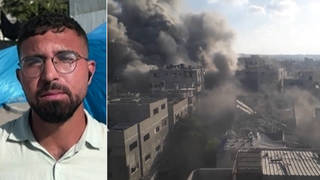
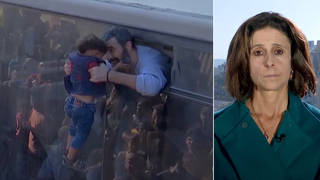
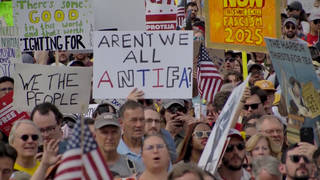
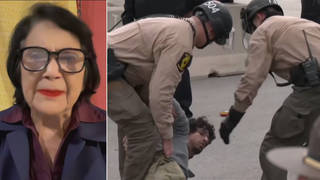





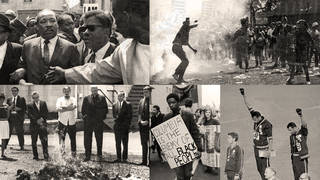
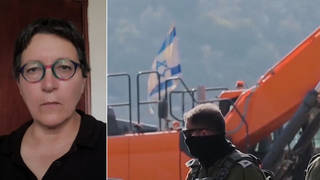
Media Options